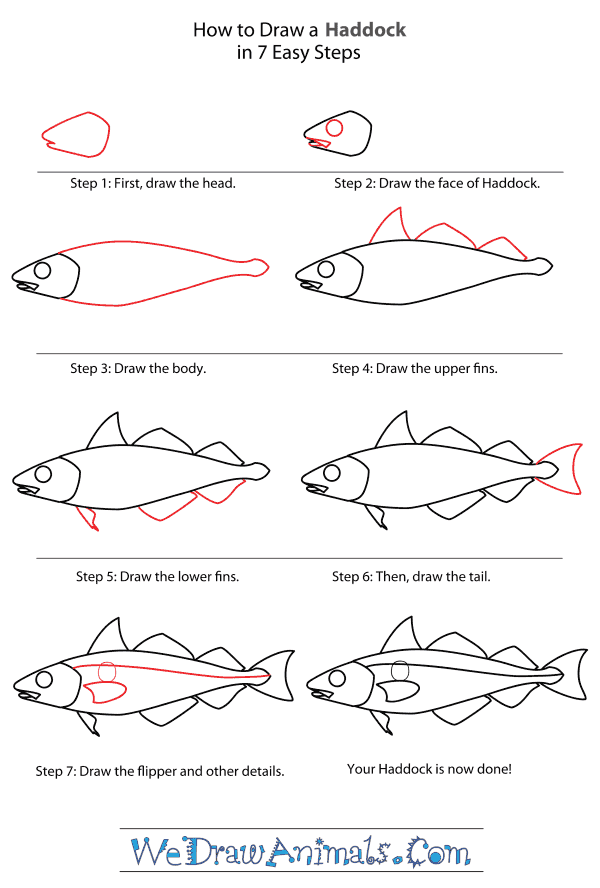In this quick tutorial you'll learn how to draw a Haddock in 7 easy steps - great for kids and novice artists.
The images above represent how your finished drawing is going to look and the steps involved.
Below are the individual steps - you can click on each one for a High Resolution printable PDF version.
At the bottom you can read some interesting facts about the Haddock.
Make sure you also check out any of the hundreds of drawing tutorials grouped by category.
How to Draw a Haddock - Step-by-Step Tutorial
Step 1: To draw the head of the Haddock, create a cone shape with a slight opening for the mouth.
Step 2: To add the facial features of the Haddock, add a circle for the eye. Next add to lines to form the mouth.
Step 3: The next step is to create your Haddock's body. To do this, draw a curved line going from the top of the head and curving down I the back to form a point. Next draw a line for the bottom of the head and have it curve to meet the point on the other end.
Step 4: You will now need to add the upper fins. Draw three different sized triangles on top of the Haddock's body.
Step 5: Next you will need to add the lower fins to the bottom part of the body. Draw the back two lower fins the same way as the top two back fins. Then draw a thin triangle fin coming out from the bottom.
Step 6: You will now need to add the tail. To draw the tail, draw a triangle with rounded lines on the back of the body.
Step 7: For the final part you will need to draw the flipper and other body details. To draw the flipper, draw a semi-circle with a connecting line behind the head. Then draw a line extending from the top of the head all the way to the middle of the tail. You have now completed your Haddock.
Interesting Facts about the HADDOCK
The Haddock is a member of the fish family and the scientific term for them is Melanogrammus aeglefinus. This species is an ocean fish that has a short curved black stripe above each white shoulder, and lives in the coastal North Atlantic Ocean. They eat invertebrates, with adults residing in deep waters and the babies staying in more shallow depths. It’s widely used by humans for food.
Did you know?
- The animal was first documented in 1758.
- The tolerable water temperature for this fish is 36 degrees Fahrenheit.
- They can swim up to almost 1,000 feet deep.
- The fish can have up to 3 million eggs per year.
- They can grow up to almost 4 feet long.
The species is most active during their spawning season between January and June, especially in late March and early April. This animal is subjected to parasites such as the cod worm, a small crustacean larvae. It swims to the fish with its eggs and attaches to the gills. There it enters the heart through the main artery and consumes blood nutrients until the babies hatch. Since there are so few of these creatures, they are vulnerable to extinction.








